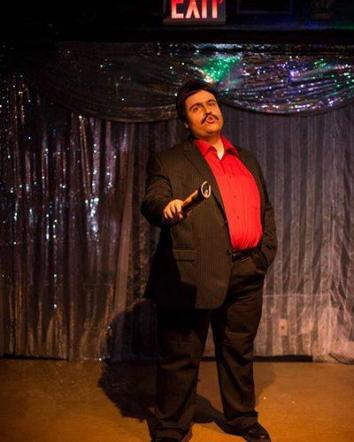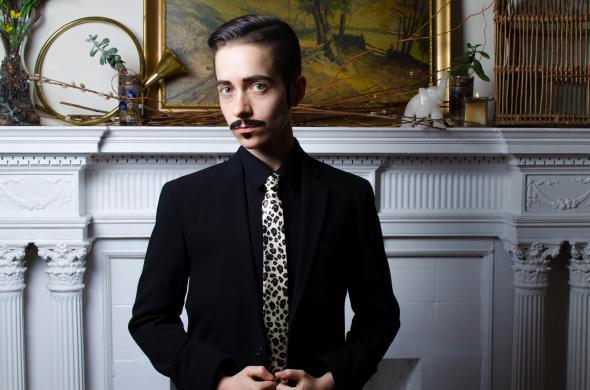I have a confession: If you’ve been following my writing on drag in Outward for the past year, you’ve only gotten half of the story. Thus far, I’ve focused solely on the experiences of men who dress up in feminine attire, drag queens like myself. I’ve failed to feature the voices of women in drag—most notably women and who dress as men, or drag kings—and some of you have noticed. “I wonder, why didn’t you talk to a female drag performer?” a reader wrote in a disappointed email. “I would have been interested to know how she sees her role.”
My gut reaction is to act like a RuPaul’s Drag Race contestant and hide behind some God damn excuses. I’m not an expert on drag kings—indeed, I know very little about them at all—so how can I speak on their behalf? But, after a little reflection, I’ve realized that my oversight is symptomatic of a much larger problem: Through interviews with working drag kings, l learned how many of us queens are blind to our female counterparts—and how that blindness has divided the drag community, especially in my own New York scene.
My first encounter with the divide between kings and queens came a few weeks ago when I co-hosted a drag competition on the Upper Upper West Side. Male performers dominated the night; about five drag queens from all over the city received standing ovations throughout the competition. But the sole drag king, Gary Carmichael, received only mild applause. And though Carmichael served an epic lip synch of “Wake Up, Everybody” by Teddy Pendergrass, Harold Melvin & the Blue Notes, the prize went to a petite queen who delighted everyone with an unexpected costume change. After the show, I was backstage fussing with my ten-dollar wig when Carmichael walked in. “It’s hard to be the only one trying to break down barriers,” he said, half to me and my co-hostess, half to himself. Then he threw his bags together and left.

Credit: Gary Carmichael’s Facebook page.
Back then, I barely knew Carmichael, having only glimpsed him a few times, so I assumed he was simply upset about the night’s defeat. But during a recent interview, he explained the history behind his anger. “I should take a survey of every audience I perform for: How many of you know what a drag king is? How many of you have seen one perform?” Carmichael told me. “Because RuPaul’s Drag Race has put queens into the mainstream, but most people still don’t understand kings.”
Before talking to Carmichael and other kings, I was one of those people. I saw the drag king community as a foot note in drag culture, comprising performers who lip-synched to Elvis while wearing Hanes tees. But the more I learned about the craft of king drag, the more I came to see it as a perfect companion to the world of queens—a creative, irreverent group of performers dedicated to exploring and parodying notions of gender through art. Like queens, kings create elaborately costumed, choreographed performance spectacles. They labor to master makeup skills, exchanging trade secrets from king to king or through YouTube tutorials. Like queens, they blend their own feelings about gender with the representations of gender in popular culture. Like queens, their reasons for falling in love with drag range from the quotidian to the profound—some come to the art by accident, some for the love of performance, some through a life-long yearning to explore their gender identity. There’s so much we could learn from each other.
And yet the mainstream queen scene (at least in New York) remains blissfully ignorant of kings. In the past year, I myself have participated in at least five interviews where I was asked about the drag king community, and every time I was content to offer a Palin-esque, “Oh gosh, I don’t know about all that.” In retrospect, this is inexcusable behavior, especially for someone branding herself as a spokesperson for the drag community. But as cathartic as it would be to offer a mea culpa, I have to acknowledge that my attitude has been shaped in part by New York’s very insular queen subculture. Yes, in smaller towns like my own home town, kings and queens are thrown together by necessity in the few available queer spaces. But here in the city, and in too many other big towns, they remain segregated. Overtly or tacitly, most of the venues that feature drag queens keep drag kings at a distance.
Indeed, Carmichael explained that audiences at male drag venues are so conditioned to cheer for queens that they sit in baffled silence through even the best king’s performance. And queens do little to help audiences engage, because they too are often ignorant about kings—or worse yet, disdainful of them. “I’ve had to explain to a queen what a drag king is, because she’d never heard of the term,” Carmichael said. “Once, when I told a drag queen about my work in drag, she told me that no one would be interested in seeing a woman dressed as a man.” Having achieved mainstream visibility and the bookings that come along with perceived legitimacy, many queens support fellow male performers, but shrug off the female members of drag culture.

Photo credit: Elisabeth Fuchsia
According to drag kings Lee VaLone and K. James the divide between queens and kings is a problem that pre-dates the age of RuPaul’s Drag Race and has badly damaged drag culture. As members of Switch n Play, a Brooklyn drag alliance committed to “creating safe space for drag, burlesque and other gender-based performance,” VaLone and James are well versed in the city’s drag history. “In the 1990s, kings were very strong in New York,” VaLone explained in a phone interview, “But then—I don’t know how else to put it—there was so much shaming from the drag queen community that the king movement stopped and moved elsewhere.” When queens gained power and popularity in the early aughts, they began to dominate queer spaces and edge kings out. As a result, the king community in New York today is so small that it has been rendered nearly invisible. Of course, there are still a few highly successful New York kings like Murray Hill, but the rich community of kings behind them has all but disappeared.
So when kings show up at drag venues in today’s New York, they are often treated as misfits. VaLone feels uncomfortable in male-dominated drag bars.* He has learned to stay away from mainstream performance spaces in Chelsea and Hell’s Kitchen because of the way queens and their audiences have treated him. “Drag is a mode of expression for me, not a way to pay the bills,” he told me, “so I don’t feel like I have to go to cis-male spaces if no one’s taking my drink order and all I’m getting is side-eye.” When VaLone does interact with queens, it’s through groups like Switch n Play, created specifically for breaking down boundaries between gender performers.
It’s disappointing to hear about drag queens creating unwelcoming queer spaces, especially when they make such a fuss about celebrating diversity. But if VaLone is right, and the divisions between kings and queens are fairly new, perhaps they can be healed. There are already a handful of mainstream queens in New York gayborhoods that welcome kings to participate in drag competitions—in fact, Carmichael just won such a competition last week. There are already spaces like Switch n Play where the usual boundaries are being joyfully eroded. These queens and venues could serve as a models for the rest of the drag community, demonstrating that it’s possible for queen audiences to accept kings, and for queens themselves to acquire a broader understanding of drag. I think it’s time to begin this process—and I’m not the only one.
“People tell me that New York nightlife used to be a potluck where all kinds of drag and burlesque came together without all the segregation,” Crimson Kitty told me, “And I want to see that potluck.” Kitty represents another even less visible category of female drag performer—the female queen, or faux queen as they are sometimes called. Raised by the underground burlesque scene and by drag queen Rebecca Glasscock, Kitty has become a poster child for what she calls “drag equality,” and the infinite diversity within the drag world. I like her vision for a unified drag community, the “potluck” in which creative energy is freely exchanged among kings, queens, and everything in between. She imagines a drag culture where gender performers see only what they have in common. “Drag performers should realize we’re all doing the same job—nightlife. The intensity of the beat, the transformation process is the same,” Kitty says. “Nightlife is our job, and our makeup is our uniform.”
*Correction, Apr. 9, 2015: This article originally misattributed a series of quotes from drag performer Lee VaLone to drag peformer K. James.
